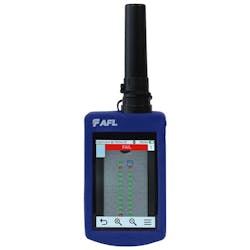AFL’s new FOCIS Lightning®2 Multi-Fiber Optic Connector Inspection System is “engineered to dramatically facilitate and streamline fiber connector inspection,” the company said when introducing the system on September 19, adding that the second-generation system enables service providers, enterprise, and data center operators “to efficiently inspect and validate their fiber connectivity.”
Plug-and-play connectorized cabling systems have been instrumental in speeding up and simplifying fiber network deployment, AFL explained. First taking hold in hyperscale and enterprise data centers, these preterminated systems are now commonly used in 5G and FTTx networks.
“Since contaminated connectors remain one of the primary causes of network failure, the need to rapidly inspect and validate fiber endfaces for cleanliness has become critical,” AFL added.
“Fiber technicians are often tasked with multiple jobs when installing fiber—from cable placement and splicing to test and inspection,” said David Tanis, senior product manager for AFL’s Test and Inspection group. “The tools they use must be intuitive as they don’t have the time to re-learn how to use them every time they pick them up. FOCIS Lightning2 addresses this challenge by providing a very simple-to-operate fiber probe that can be used right out of the box.”
FOCIS Lightning2 features a self-contained, palm-sized design and one-button operation that make inspecting crowded fiber patch bays quick and easy, AFL emphasized. A large, high-resolution LCD touch screen improves visibility of MPO and single-fiber connectors for advanced analysis. It is part of AFL’s test and inspection portfolio, whose hallmarks are ease of use, fast processing, and a compact design. AFL added that its test and inspection solutions “provide quick results, including OTDRs, fiber identification tools, optical power meters, test kits, cleaning, and more.”
Specific characteristics of FOCIS Lightning2 include the following.
- Field of view, multiple fibers: 3200x4800 µm
- Field of view, single fiber: 1314x2144 µm
- Display: LCD touch screen, 320x480
- File formats: 640x480 pixels, JPG, GIF
- Storage capacity: 10,000 files
- Battery: 8 hours, Li-Pol, user-replaceable
The system provides pass/fail analysis according to IEC 61300-3-35. It also complies with the upcoming revision to that standard, which currently is in late stages of the approval process.
Elaborating on the importance of fiber inspection, AFL’s Tanis stated, “New does not equal clean. New connectors can fail inspection out of the box.” While providing that level of assurance, he added, FOCIS Lightning2 offers a simple and user-friendly design, the ability to share results easily, as well as fast and accurate results generation.
You can find more information on the FOCIS Lightning2 Fiber Inspection System here.
